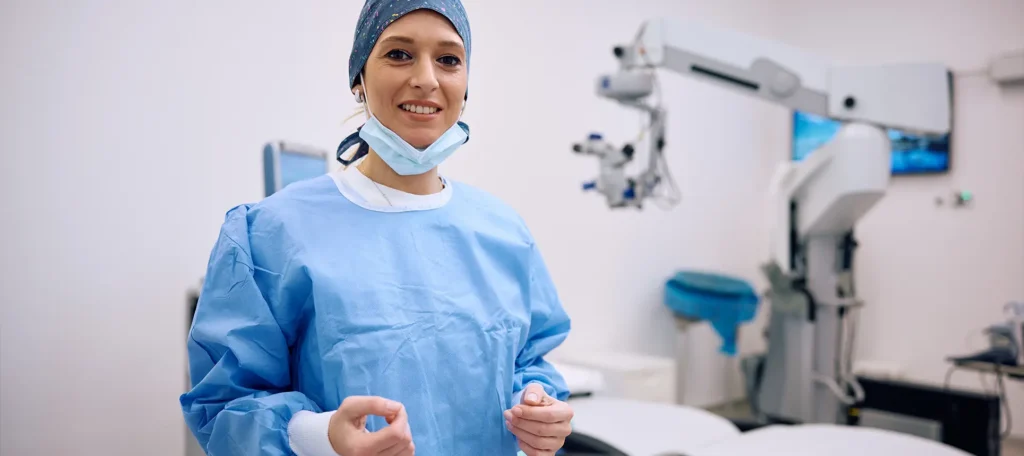Trigeminal neuralgia is one of those conditions that’s not just physically painful, but can also complicate other areas of life — like having cataract surgery. If you’re living with trigeminal neuralgia and have been told you need surgery for cataracts, you might be wondering how the two conditions interact. Will the facial pain make the procedure harder? What about blinking and corneal protection? Will the anaesthetic trigger anything? And can you still expect a good visual result?
This article is written with you in mind. We’ll go over the risks, the specific precautions your eye surgeon will take, and what recovery might look like when you’re dealing with trigeminal neuralgia on top of cataracts. While the condition presents some unique challenges, there are safe and proven ways to manage them — and ensure you get the sight restoration you deserve.
Understanding Trigeminal Neuralgia and Why It Affects Cataract Surgery

Trigeminal neuralgia (TN) affects the fifth cranial nerve — the one responsible for sensation in your face, including around your eyes, forehead, and jaw. In some cases, the pain is sharp and stabbing, often triggered by even the lightest touch or movement. Other people may experience a dull ache, tingling, or a burning sensation that doesn’t go away. The unpredictable nature of TN makes it challenging to manage in daily life — and it adds extra layers of complexity to surgical planning.
The first major issue during cataract surgery is facial muscle control. While TN doesn’t directly paralyse the face like Bell’s palsy, the discomfort it causes may make it hard to stay relaxed or still. It can also interfere with natural eye closure or blinking — especially if you’ve learned to avoid blinking to reduce pain. This raises concerns around corneal protection both during and after the procedure.
Additionally, trigeminal neuralgia may involve medications like carbamazepine or gabapentin, which can interact with sedatives or anaesthetics. There’s also a real need to avoid triggering a flare-up of pain either during surgery or as part of the recovery process. With the right planning, though, these hurdles can be carefully addressed.
How Your Surgical Team Prepares for Your Condition

When you let your cataract surgeon know you have trigeminal neuralgia, they won’t see it as an obstacle — they’ll see it as something to plan around. One of the most important steps in your care will be coordinating with both your GP and your neurologist, if you have one. This allows the surgical team to understand your current medication routine, pain triggers, and any nerve involvement near the eye.
One crucial decision will be about the type of anaesthetic used. While most cataract surgeries in the UK are performed under local anaesthetic with sedation, some patients with TN may benefit from additional nerve blocks or alternative anaesthetic approaches. Your comfort — and safety — is the priority.
The team will also be prepared to manage any blink or lid closure issues during surgery. Tools like lid speculums and moisture shields are used to prevent drying of the cornea. And, post-operatively, lubricating drops and ointments may be given to ensure the eye stays hydrated and protected while healing.
Managing Pain Sensitivity During and After the Procedure
Perhaps one of the biggest concerns for anyone with trigeminal neuralgia facing surgery is the fear of pain — not from the eye, but from facial nerve flare-ups. This is entirely valid, and it’s something the team will take very seriously.
Firstly, they’ll try to avoid excessive touching or manipulation of the areas where your pain tends to be triggered. That may include adjusting how drapes are placed around the face, minimising pressure near the cheek or temple, or even adjusting the way the surgical microscope is positioned to reduce discomfort.
Post-operatively, your recovery may need to include strategies to prevent neuralgia pain spikes. This might mean pre-emptively adjusting medications, managing environmental triggers (like wind, cold, or brushing the face), and choosing a follow-up schedule that ensures rapid response if pain flares up.
If you’re using medications that lower your pain threshold or affect nerve signalling, these too may need to be reviewed before surgery — always under supervision, never on your own. Communication is key.
Protecting the Eye Surface: Why Blinking Matters
While most people don’t think about their blink reflex until something goes wrong, it becomes absolutely central in your case. People with trigeminal neuralgia may subconsciously suppress blinking due to pain, or blink irregularly, which affects how tears coat the eye. That might sound minor, but during and after cataract surgery, it really matters.
The cornea — the clear front surface of your eye — depends on regular blinking to stay moist and protected. During surgery, your surgeon will take control of this by keeping the eye open with a special device and applying lubricating drops or gels to protect it. But after the procedure, it’s up to you and your care team to keep the surface protected.
If blinking is irregular or painful post-op, there’s a risk of developing dry eye symptoms or even corneal abrasions. To counter this, you’ll likely be prescribed artificial tears, thicker ointments for night use, and possibly even moisture chamber goggles. These simple but effective strategies can make a world of difference to your comfort and healing.
Visual Recovery: What Can You Expect?
Despite the additional considerations involved, many people with trigeminal neuralgia still enjoy excellent visual outcomes after cataract surgery. The key is careful pre-op planning and diligent post-op follow-up. You might need more frequent check-ups initially to ensure the eye surface remains healthy and that pain isn’t interfering with your recovery.
It’s also important to manage expectations. Your vision might be blurred for a little longer than average — not necessarily because of the cataract surgery itself, but due to issues like tear film irregularity or nerve sensitivity. That said, most patients still report a significant improvement in their ability to see clearly and perform daily activities.
Keep in mind, too, that many people feel more confident and independent once their vision is restored. If you’ve been coping with both vision issues and facial pain, being able to see clearly again can help you better manage your TN triggers — from reading medication labels to recognising food textures, or simply reducing the anxiety that comes with poor sight.
Post-Op Care Considerations for Trigeminal Neuralgia Patients

When it comes to aftercare, patients with trigeminal neuralgia often benefit from a more tailored approach. Your drops regimen may need adjusting if application causes pain. In some cases, preservative-free drops are recommended, as they’re gentler on the ocular surface and less likely to trigger stinging.
You might also be asked to use cooling eye masks, not just for swelling, but to reduce the sensation of heat or pressure that can exacerbate TN. For some patients, touchless drop dispensers or assisted applicators can help if facial sensitivity makes it hard to handle medication close to the eye.
And importantly, don’t hesitate to reach out if anything feels off. Whether it’s eye pain, increased neuralgia activity, or unusual sensations, your surgical team would rather hear from you early. Recovery should be a partnership — one built on open communication and shared problem-solving.
Can Trigeminal Neuralgia Get Worse After Surgery?
This is a common and completely understandable worry. The short answer is: not usually. Cataract surgery itself doesn’t tend to affect the trigeminal nerve roots or worsen the underlying neuralgia. However, indirect factors like surgical stress, anxiety, or shifts in medication schedules can sometimes trigger a flare-up.
To prevent this, many surgeons coordinate closely with neurologists, especially if you’re on antiepileptic drugs or tricyclics for pain management. Making sure these medications stay consistent before and after the procedure is key.
It’s also helpful to schedule surgery at a time when your TN is relatively well-controlled. If you’ve recently had a flare or dose change, it might be safer to wait a few extra weeks to ensure your condition is stable. Patience really does pay off in cases like this.
FAQ: Trigeminal Neuralgia and Cataract Surgery
- Is trigeminal neuralgia a reason to avoid cataract surgery?
Not at all. Having trigeminal neuralgia doesn’t mean you can’t undergo cataract surgery, but it does mean your care needs to be tailored. Your surgeon will consider factors like your pain triggers, blinking ability, and how your medications interact with anaesthetics. With the right precautions and planning, you can safely have cataract surgery and achieve excellent visual results, even with a complex condition like TN. - Will cataract surgery make my trigeminal neuralgia worse?
Cataract surgery itself doesn’t directly impact the trigeminal nerve, so it rarely worsens the condition. However, any surgical procedure can introduce physical stress, anxiety, or disruptions to medication routines — all of which can potentially trigger a flare-up. This is why it’s so important to keep your neurologist in the loop and to schedule surgery at a time when your TN is relatively stable. - Can I continue taking carbamazepine or gabapentin before cataract surgery?
In most cases, yes, but your cataract surgeon will need to know exactly what you’re taking. Carbamazepine, gabapentin, and other neuropathic pain medications can interact with sedatives or anaesthetic agents, so your medical team may adjust timing or dosage slightly for safety. Stopping these medications abruptly is not advised, so coordination with your neurologist is essential to avoid complications. - What if I can’t blink properly during recovery?
If blinking is irregular or incomplete due to trigeminal neuralgia, your surgeon will take extra steps to protect the surface of your eye. This often includes prescribing lubricating eye drops, thicker ointments for night-time use, and sometimes moisture chamber goggles. These interventions help prevent the cornea from drying out, keeping it comfortable and reducing the risk of damage while you heal. - Will anaesthetic injections near my eye trigger facial pain?
Your surgical team will be very careful to avoid triggering pain during the procedure. In some cases, the local anaesthetic may be delivered in a gentler way or combined with sedation to make the experience more comfortable. Your pain history and sensitive areas will be discussed in advance, allowing the anaesthetist and surgeon to adjust their technique accordingly and reduce the chance of flare-ups. - Can I still lie flat for surgery if I have facial pain?
Yes, although lying flat is the standard position for cataract surgery, accommodations can be made. If your facial pain worsens in certain positions, the surgical bed and headrest can often be adjusted to relieve pressure. Let your surgeon know in advance so they can position you comfortably — especially if your trigeminal neuralgia affects one side of the face more than the other. - How soon can I return to my neurologist’s care after the surgery?
You won’t need to pause neurological care for cataract surgery. In fact, it’s helpful for your neurologist and ophthalmologist to coordinate during your recovery. After surgery, you can typically resume routine neurology appointments within a few days to a week. If any flare-ups or medication adjustments are needed post-op, your neurologist will help guide that process safely. - Are there special drops for people with TN after surgery?
Yes, preservative-free or low-irritant eye drops are often used for people with facial nerve sensitivity, as they are gentler on the eye and less likely to trigger stinging or discomfort. Your surgeon may also recommend cooling gels or lubricants to soothe the ocular surface and support healing. If applying drops is painful, assistive devices can make it easier and more comfortable. - Can stress from surgery worsen trigeminal neuralgia symptoms?
Unfortunately, yes — stress is one of the most well-known triggers for trigeminal neuralgia flare-ups. That’s why managing anxiety before and after surgery is a key part of your care. Your team might offer sedatives during surgery, and calming techniques like mindfulness or controlled breathing can help reduce stress. The goal is to keep your nervous system as calm as possible while your eye recovers. - How do I prepare for surgery if I have both TN and dry eye?
Having both conditions means you’ll need a proactive strategy for surface protection and comfort. Tell your surgeon about any dry eye symptoms you experience, even if they seem minor. You’ll likely be prescribed artificial tears and gels well before surgery, with a plan to continue them after. Together with your blink pattern and TN management, this will help ensure a smooth and safe outcome.
Final Thoughts: You’re Not Alone in This
If you’ve been feeling hesitant about having cataract surgery because of your trigeminal neuralgia, that’s completely normal. But the truth is, you’re not the first person to be in this position — and experienced eye surgeons in the UK are well-prepared to handle complex conditions like this.
The most important thing is to keep the lines of communication open. Make sure your ophthalmologist knows about your TN diagnosis and how it affects your daily life. Don’t minimise your symptoms — it’s better to over-explain than to leave out something important.
At London Cataract Centre, we regularly care for patients with neurological or facial nerve conditions, including trigeminal neuralgia. We take a personalised approach to make sure your surgery is as safe, comfortable, and successful as possible. With the right pre-surgical planning, careful intraoperative protection, and customised post-op care, you can absolutely have a smooth experience — and enjoy clearer vision without compromising your comfort.
References
- Giannaccare, G., Barabino, S., Di Zazzo, A. & Villani, E., 2024. Preventing and managing iatrogenic dry eye disease during the entire surgical pathway: a study focusing on patients undergoing cataract surgery. Journal of Clinical Medicine, 13(3), p.748. Available at: https://doi.org/10.3390/jcm13030748
- Mencucci, R., Favuzza, E., Decandia, G., Cennamo, M. & Giansanti, F., 2021. Hyaluronic acid/trehalose ophthalmic solution in reducing post‑cataract surgery dry‑eye signs and symptoms: a prospective, randomized, open‑label study. Journal of Clinical Medicine, 10(20), p.4699. Available at: https://doi.org/10.3390/jcm10204699
- Grzybowski, A. & Ruamviboonsuk, P., 2019. Management of dry eye disease to optimize cataract surgery outcomes. International Ophthalmology Clinics, 59(2), pp.79–90. Available at: https://pubmed.ncbi.nlm.nih.gov/31351686/

